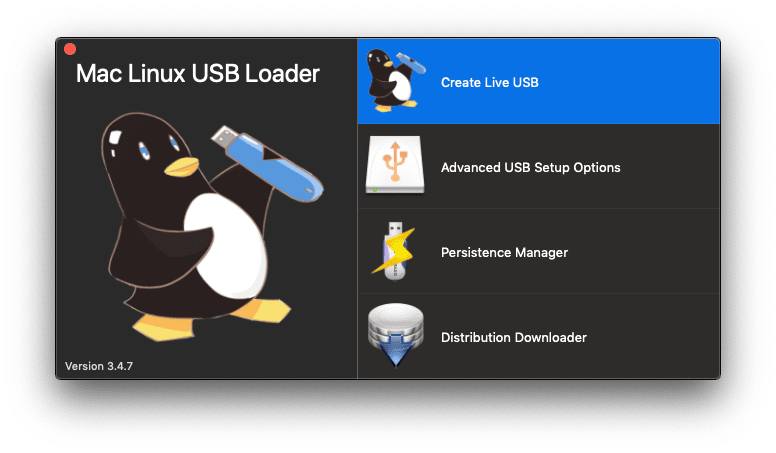Linux Mint For Mac On Usb Sevenbits Persistance Not Working
Join GitHub today
I looked around and still can't find a good guide. I want to make a USB Live with persistent so I can save data, install software packages and everything and still have it after reboot. I wanna use this USB live on mac as well as Windows. Yes, I wanna boot from USB not install it as a second OS. One big feature that Linux Mint is missing though is the ability to create a Live USB stick with persistent storage. In this tutorial I'll show how to create a Linux Mint Persistent Live USB drive.
GitHub is home to over 40 million developers working together to host and review code, manage projects, and build software together.
Sign upHave a question about this project? Sign up for a free GitHub account to open an issue and contact its maintainers and the community.
By clicking “Sign up for GitHub”, you agree to our terms of service and privacy statement. We’ll occasionally send you account related emails.
Already on GitHub? Sign in to your account
Comments
commented Sep 3, 2016
Short Description of Problem: Expected Behavior: Actual Behavior: Steps to Reproduce: Note: You can include screenshots and other media by dragging and dropping them onto this text area. Please do so, it helps solve your problem! |
commented Sep 3, 2016
@oproz Hi there, just to clarify: Mac Linux USB Loader’s built-in persistence tool only works with Ubuntu-based distributions. Kali requires separate steps which are detailed in this video (which I am linking to for informational purposes and do not endorse): https://www.youtube.com/watch?v=mDRbTHCoj8U |
commented Sep 6, 2016
@oproz Will close unless I receive more input from you. |
Fifa 15 game for wii. These steps will not work for Kali Linux. To setup persistence on Kali Linux, please see the article on Kali’s Knowledge Base.
UPDATE: As of Mac Linux USB Loader version 3.0, released on 24 December 2014, these instructions are out of date. Mac Linux USB Loader now includes a built-in method for setting up persistence on your USB drive. You can still follow these instructions, however, they are no longer the recommended method.
The Lowdown
Persistence is a cool feature of most Linux distributions. Before now, it's been restricted to just PC only in most cases. Not anymore!Enterprise, Mac Linux USB Loader's UEFI program that boots your USB, supports persistence. Lucky you.

In the future, Mac Linux USB Loader will support setting up persistence natively from the GUI. In the interim period, persistence needs to be set up manually and from within Linux, as OS X is missing some of the tools needed to build persistence files (mainly because OS X is BSD based and we want to deal with Linux, which isn’t UNIX, even though people like to think it is). If you must use OS X, you can, but you'll need a copy of E2fsprogs for Mac and the second command will be different.
From within Linux, you’ll need to mount your USB drive (hopefully you’ll know how to do this ;) ) and note the mount point. Then you need to execute the following commands, assuming that your USB drive is mounted at /media/usb.
Getting Our Hands Dirty
First, you need to create a persistence file at the root of the drive in the partition that you’ll be booting. In this command, x is the number of MBs that you want your persistence file to be (1024 = 1 gigabyte, but large files take a long time to make and slow down the boot process).
In this example, we’re enabling 128 MBs of persistence, so replace x with 128. This is enough for most uses if you're just going to be installing WiFi drivers and typing documents, but if you'll be doing something crazy like installing nVidia drivers and playing Xonotic, you may just want to bump that up a bit.
Then, we need to make a file system inside of that file, which Linux will mount as a loopback file. This is complex stuff, but it’s similar to how Macs can mount DMG files. Again, assuming that your USB drive is /media/usb, the command to type is:
Mac users: your command is totally different. Install your copy of E2fsprogs for Mac somewhere, perhaps /usr/local/bin, and then execute this command:mke2fs -t ext4 /Volumes/USB/casper-rw (assuming that USB is the name of your USB)
You’ll be asked if you want to do the command even though the file is not a “block special device” (i.e a block device under the /dev folder). Type “y” (without quotes) to indicate yes, you do.
After this, boot your USB drive. Enterprise will tell you that you have a persistence file and that you can enable persistence. To use it, go into the advanced boot options menu and press the key to indicate that you want to boot with persistence. You can see a screenshot of this screen below:
Then, enable any other options that you want (if any) and then press 0 (zero) and boot your drive and it should all work magically. Please note that you must toggle this option each time you wish to boot with persistence.